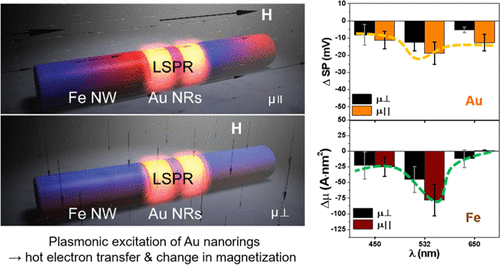当前位置:
X-MOL 学术
›
Chem. Mater.
›
论文详情
Our official English website, www.x-mol.net, welcomes your
feedback! (Note: you will need to create a separate account there.)
Understanding Optomagnetic Interactions in Fe Nanowire–Au Nanoring Hybrid Structures Synthesized through Coaxial Lithography
Chemistry of Materials ( IF 7.2 ) Pub Date : 2020-03-25 , DOI: 10.1021/acs.chemmater.9b04666 Seung-Hoon Lee 1, 2 , Taegon Oh 3 , Jehyeok Ryu 4 , Chad A. Mirkin 3, 5 , Jae-Won Jang 6
Chemistry of Materials ( IF 7.2 ) Pub Date : 2020-03-25 , DOI: 10.1021/acs.chemmater.9b04666 Seung-Hoon Lee 1, 2 , Taegon Oh 3 , Jehyeok Ryu 4 , Chad A. Mirkin 3, 5 , Jae-Won Jang 6
Affiliation

|
Ferromagnetic Fe nanowires surrounded by two plasmonic Au nanorings (FeAuNRsNWs) were synthesized by coaxial lithography (COAL). They were characterized under irradiation (three different wavelengths) and an external magnetic field applied either parallel or perpendicular to the long axes of the wires using magnetic force microscopy (MFM) and Kelvin probe force microscopy (KPFM). The field directs the magnetic spin alignment of the nanowires. Through these studies, two important properties of FeAuNRsNWs, which derive from plasmon–spin interactions, have been discovered. First, with both parallel and perpendicular spin alignments (relative to the wire axis), hot-electron-enhanced magnetization is observed, as evidenced by plasmon-induced changes in both the surface potential and MFM phase values. Second, the observed enhancement when the spin alignment is perpendicular to the wire axis is smaller than that observed for parallel alignment. Both of these observations are a consequence of hot electron transfer from the Au nanorings to the Fe nanowire and the interaction between the plasmon-induced internal magnetic field and the external magnetic field in the FeAuNRsNW. This conclusion is further supported by finite-difference time domain (FDTD) and finite element method (FEM) simulations. In addition to being an excellent testbed for examining plasmon–spin interactions as a way to control magnetic spins with light, these FeAuNRsNWs, and their ring structure-dependent properties point toward a pathway for tailoring plasmon–spin interactions.
中文翻译:

了解通过同轴光刻合成的Fe纳米线-Au纳米环杂化结构中的光相互作用。
通过同轴光刻技术(COAL)合成了被两个等离子Au纳米环(Fe AuNRs NWs)包围的铁磁Fe纳米线。它们在辐射(三种不同波长)下进行了表征,并使用磁力显微镜(MFM)和开尔文探针力显微镜(KPFM)平行或垂直于导线的长轴施加了外部磁场。该场指导纳米线的磁自旋对准。通过这些研究,发现了Fe AuNRs的两个重要特性已经发现了源自等离激元-自旋相互作用的NW。首先,通过平行和垂直自旋对准(相对于线轴),观察到热电子增强的磁化强度,这由等离激元引起的表面电势和MFM相值的变化证明。第二,自旋对准垂直于导线轴时观察到的增强小于平行对准时观察到的增强。这两个观察结果都是热电子从Au纳米环转移到Fe纳米线的结果,以及Fe AuNRs中由等离激元引起的内部磁场与外部磁场之间的相互作用。NW。有限差分时域(FDTD)和有限元方法(FEM)模拟进一步支持了这一结论。这些Fe AuNRs NWs除了是检验等离激元-自旋相互作用作为控制光的自旋的一种极好的试验台之外,它们的环结构依赖性还指向定制等离激元-自旋相互作用的途径。
更新日期:2020-04-23
中文翻译:

了解通过同轴光刻合成的Fe纳米线-Au纳米环杂化结构中的光相互作用。
通过同轴光刻技术(COAL)合成了被两个等离子Au纳米环(Fe AuNRs NWs)包围的铁磁Fe纳米线。它们在辐射(三种不同波长)下进行了表征,并使用磁力显微镜(MFM)和开尔文探针力显微镜(KPFM)平行或垂直于导线的长轴施加了外部磁场。该场指导纳米线的磁自旋对准。通过这些研究,发现了Fe AuNRs的两个重要特性已经发现了源自等离激元-自旋相互作用的NW。首先,通过平行和垂直自旋对准(相对于线轴),观察到热电子增强的磁化强度,这由等离激元引起的表面电势和MFM相值的变化证明。第二,自旋对准垂直于导线轴时观察到的增强小于平行对准时观察到的增强。这两个观察结果都是热电子从Au纳米环转移到Fe纳米线的结果,以及Fe AuNRs中由等离激元引起的内部磁场与外部磁场之间的相互作用。NW。有限差分时域(FDTD)和有限元方法(FEM)模拟进一步支持了这一结论。这些Fe AuNRs NWs除了是检验等离激元-自旋相互作用作为控制光的自旋的一种极好的试验台之外,它们的环结构依赖性还指向定制等离激元-自旋相互作用的途径。

































 京公网安备 11010802027423号
京公网安备 11010802027423号